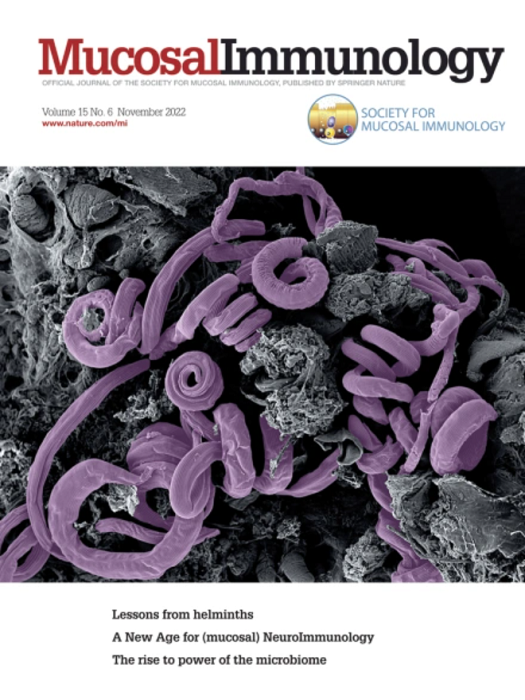Itaconate suppresses house dust mite-induced allergic airways disease and Th2 cell differentiation
IF 7.9
2区 医学
Q1 IMMUNOLOGY
引用次数: 0
Abstract
Itaconate was initially identified as an antimicrobial compound produced by myeloid cells. Beyond its antimicrobial role, itaconate may also serve as a crucial metabolic and immune modulator. We therefore examined the roles of aconitate decarboxylase 1 (Acod1) and itaconate in house dust mite (HDM)-sensitized and −challenged mice, a model of T helper 2 (Th2)-driven allergic airways disease. HDM treatment induced lung Acod1 mRNA expression and bronchoalveolar lavage (BAL) itaconate levels in wild-type C57BL/6 mice. Acod1 knockout mice (Acod1-KO) with negligible BAL itaconate showed heightened HDM-induced type 2 cytokine expression, increased serum IgE, and enhanced recruitment of Th2 cells in the lung, indicating a shift towards a more pronounced Th2 immune response. Acod1-KO mice also showed increased eosinophilic airway inflammation and hyperresponsiveness. Experiments in chimeric mice demonstrated that bone marrow from Acod1-KO mice is sufficient to increase type 2 cytokine expression in wild-type mice, and that restitution of bone marrow from wild type mice attenuates mRNA expression of Th2 cytokines in Acod1-KO mice. Specific deletion of Acod1 in lysozyme-secreting macrophages (LysM-cre+Acod1flox/flox) recapitulated the exaggerated phenotype observed in whole-body Acod1-KO mice. Adoptive transfer of Acod1-KO bone marrow-derived macrophages also increased lung mRNA expression of Th2 cytokines. In addition, treatment of Th2-polarized CD4 cells with itaconate impeded Th2 cell differentiation, as shown by reduced expression of Gata3 and decreased release of IL-5 and IL-13. Finally, public datasets of human samples show lower Acod1 expression in subjects with allergic asthma, consistent with a protective role of itaconate in asthma pathogenesis. Together, these data suggest that itaconate plays a protective, immunomodulatory role in limiting airway type 2 inflammation after allergen challenge by attenuating T cell responses.
伊塔康酸能抑制屋尘螨诱发的过敏性气道疾病和 Th2 细胞分化。
伊塔康酸最初被确认为髓细胞产生的一种抗菌化合物。除了抗菌作用外,它肯酸酯还可能是一种重要的代谢和免疫调节剂。因此,我们研究了乌头脱羧酶 1(Acod1)和伊他康酸盐在家养尘螨(HDM)致敏和致敏小鼠(一种 T 辅助细胞 2(Th2)驱动的过敏性气道疾病模型)中的作用。HDM处理可诱导野生型C57BL/6小鼠肺部Acod1 mRNA的表达和支气管肺泡灌洗液(BAL)中伊他康酸的水平。Acod1 基因敲除小鼠(Acod1-KO)的 BAL itaconate 含量可忽略不计,但其 HDM 诱导的 2 型细胞因子表达、血清 IgE 和肺中 Th2 细胞的招募均有所增加,这表明小鼠的 Th2 免疫反应更加明显。Acod1-KO 小鼠还表现出更严重的嗜酸性粒细胞气道炎症和高反应性。嵌合小鼠的实验表明,Acod1-KO 小鼠的骨髓足以增加野生型小鼠的 2 型细胞因子表达,而野生型小鼠骨髓的恢复可减轻 Acod1-KO 小鼠 Th2 细胞因子 mRNA 的表达。在分泌溶菌酶的巨噬细胞(LysM-cre+Acod1flox/flox)中特异性地缺失 Acod1 可重现全身 Acod1-KO 小鼠所观察到的夸张表型。收养性转移 Acod1-KO 骨髓衍生巨噬细胞也增加了 Th2 细胞因子的肺 mRNA 表达。此外,用伊塔康酸处理 Th2 极化的 CD4 细胞会阻碍 Th2 细胞的分化,表现为 Gata3 的表达减少以及 IL-5 和 IL-13 的释放减少。最后,公开的人类样本数据集显示,过敏性哮喘患者的 Acod1 表达较低,这与伊塔康酸在哮喘发病机制中的保护作用一致。总之,这些数据表明,伊它康酸通过减弱 T 细胞反应,在过敏原挑战后限制气道 2 型炎症方面发挥着保护性免疫调节作用。
本文章由计算机程序翻译,如有差异,请以英文原文为准。
求助全文
约1分钟内获得全文
求助全文
来源期刊

Mucosal Immunology
医学-免疫学
CiteScore
16.60
自引率
3.80%
发文量
100
审稿时长
12 days
期刊介绍:
Mucosal Immunology, the official publication of the Society of Mucosal Immunology (SMI), serves as a forum for both basic and clinical scientists to discuss immunity and inflammation involving mucosal tissues. It covers gastrointestinal, pulmonary, nasopharyngeal, oral, ocular, and genitourinary immunology through original research articles, scholarly reviews, commentaries, editorials, and letters. The journal gives equal consideration to basic, translational, and clinical studies and also serves as a primary communication channel for the SMI governing board and its members, featuring society news, meeting announcements, policy discussions, and job/training opportunities advertisements.
 求助内容:
求助内容: 应助结果提醒方式:
应助结果提醒方式:


